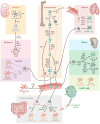The dendritic cell lineage: ontogeny and function of dendritic cells and their subsets in the steady state and the inflamed setting
- PMID: 23516985
- PMCID: PMC3853342
- DOI: 10.1146/annurev-immunol-020711-074950
The dendritic cell lineage: ontogeny and function of dendritic cells and their subsets in the steady state and the inflamed setting
Abstract
Dendritic cells (DCs) form a remarkable cellular network that shapes adaptive immune responses according to peripheral cues. After four decades of research, we now know that DCs arise from a hematopoietic lineage distinct from other leukocytes, establishing the DC system as a unique hematopoietic branch. Recent work has also established that tissue DCs consist of developmentally and functionally distinct subsets that differentially regulate T lymphocyte function. This review discusses major advances in our understanding of the regulation of DC lineage commitment, differentiation, diversification, and function in situ.
Figures






References
-
- Steinman RM. Lasker Basic Medical Research Award. Dendritic cells: versatile controllers of the immune system. Nat Med. 2007;13:1155–59. - PubMed
Publication types
MeSH terms
Substances
Grants and funding
LinkOut - more resources
Full Text Sources
Other Literature Sources

